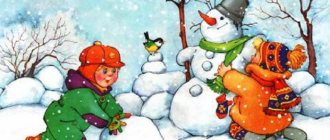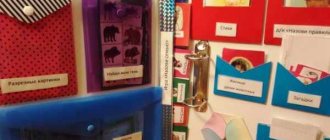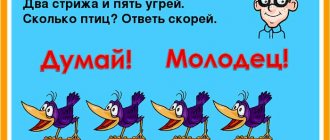Preparatory group
We offer games to consolidate and generalize knowledge about flora, expand horizons, and develop cognitive activity in preschoolers preparing for school.
Make a plant from parts
The game requires pictures divided into parts, each part representing a specific plant organ: stem, root, leaves, flowers. The game task is to create a plant from parts of the picture. It is important that the depicted representatives of the flora belong to different categories: trees, shrubs, herbs, vegetables, flowers.
Didactic game “Groups of plants”
The teacher lays out 4 pictures in front of the players, depicting plants of certain groups. The game task is to identify the extra image.
Here are the categories:
- shade-loving plants - lily of the valley, sunflower, fern, ivy;
- wild - nettle, plantain, burdock, strawberry;
- blooming - juniper, aster, lilac, flax;
- medicinal - chamomile, hawthorn, sedge, coltsfoot;
- poisonous - henbane, clover, crow's eye, castor bean;
- conifers - spruce, pine, cypress, hornbeam.
Vegetable shop
Before the game starts, the teacher tells the children that agricultural crops are taken to vegetable warehouses for storage and to enterprises for processing and preservation. Fruits and vegetables that are stored fresh must be periodically sorted for spoilage. And those fruits that are immediately processed cannot be stored for a long time and quickly rot.
Children are divided into two groups: the first play farmers bringing the harvest, the second play specialists in receiving goods. To play the game you need to make images of different vegetables, berries, fruits, and also put two tables: one will be a vegetable storage, the second will be a processing plant. Each farmer player takes a picture, approaches the goods distributor with it, and he determines where the products will go: to storage or for processing.
Forester
A game played in the forest makes familiarization with plants more effective. The teacher, playing the role of a forester, goes with the children to the forest. This could be a forest belt, a city park. The forester lays out a convenient route for the children, but does not directly tell them where to turn, but describes a tree or bush, followed by a turn. Based on the description of the foliage, the color of the bark, the splendor of the crown and other parameters, attentive preschoolers must guess where to move.
Didactic games “Plants” in the senior group
We offer games for older preschoolers that expand and clarify knowledge about wild and indoor plants, their characteristics and places of growth.
Medicinal plants
The game reinforces ideas about the medicinal purposes of plants. The lesson requires pictures of medicinal herbs and shrubs known to preschoolers.
The teacher shows pictures one by one, and the children tell everything they know about the plant depicted: where it grows, what benefits it brings, what parts of it are used for medicinal purposes.
Didactic games “Indoor plants”
There are several games using indoor flowers. For classes, you need to choose potted plants that differ significantly in appearance and are familiar to preschoolers.
Game options:
- The teacher arranges flower pots in a row. First, he asks to name the plants in their order. For example, the second on the right side or the fifth on the left. Then the children perform the reverse task. The teacher asks, for example: “Where is the ficus?” The children answer: “He is third on the left side.”
- The teacher asks to name plants with certain characteristics. For example, with long hanging stems or with variegated leaves.
- Children look at the leaves of potted flowers. They share what they think the leaves of each plant look like.
- The teacher places 4–6 plants in a row. The students try to remember them, then close their eyes. The teacher removes one flower. Children, opening their eyes, try to remember which plant is missing. The game can be complicated by adding new plants to the row.
Ripe or not ripe
The game teaches you to visually determine the ripeness of fruits. The teacher lays out vegetables, berries, and fruits of varying degrees of ripening in front of the children. On command, children choose the ripest fruits among the fruits. At the second stage, they try to identify fruits of medium maturity.
The game can be active. The children are divided into two groups: the first receive ripe fruits, the second receive the same fruit, only unripe. Children dance and run to the accompaniment of music. And when the signal sounds, they try to find a friend with a similar fruit, only of a different degree of maturity.
Hang the fruit on the branch
Preschoolers are divided into two groups: the first receive branches of vegetable and tree crops, the second receive the corresponding fruits. On command, the children look for a pair, that is, they try to attach the fruit to a branch.
What types of flowers are there?
First, the teacher tells the students that there are garden, potted, forest, field, and meadow flowers. They differ in size, foliage, and inflorescences.
For the game you need images of flowers growing in different conditions. The game task is to divide the pictures into groups according to their location: forest, meadow, field, garden, house. During the differentiation process, players compare the external characteristics of plants and describe each species in detail.
Middle group
We present educational and developmental games on the theme “The World of Plants” for preschoolers of the middle age group.
Whose seed is this?
The game teaches you to differentiate cultivated plants and their seeds, improves memory and concentration, and creates cognitive interest. For the lesson, you need recognizable images of vegetables, stone fruits and pome fruits, flowering crops, as well as real corresponding seeds and seeds: sunflower, pumpkin, apricot, cherry, apple, orange, cucumber and others. The game task is to correctly arrange the seeds and pits in the pictures.
What tree are the leaves from?
The game teaches you to identify the external signs of different types of trees. And the main feature is the leaves. For the game you need to prepare pictures of trees and corresponding images of leaves. Or collect and dry real leaves: birch, aspen, rowan, willow, oak, maple and others.
The teacher places stools in a row on the playground. There is a picture of a tree on each seat. The players are given images of leaves. At the starting signal, children run to the stools, look for a tree that matches the leaf, and sit on the seat.
Top or spine
To play you need two hula hoops of different colors, images of vegetables and root vegetables.
You can play in two ways:
- The teacher places the hula hoops on the floor so that they overlap slightly. One color hula hoop is for vegetables, the other is for root vegetables. And in the intersection zone, players must place images of those crops whose above-ground and underground parts are edible. Players take turns taking a picture, putting it in the right place, and justifying their decision.
- The teacher lays out images of tops and roots on the table. Players are divided into two corresponding groups and sort out the pictures. On command, children begin to run and dance. When the signal sounds, each root player must find his pair - the top.
We treat trees
The game fosters a caring and respectful attitude towards natural objects. The teacher and preschoolers go to the park, taking with them boards, pieces of fabric, scissors, cords, and water. There, children examine trees and bushes, looking for diseased specimens: withered, withered, with broken branches. The children’s task is to help the trees, to “cure” them using scrap materials.
Let's make a bouquet
The game teaches you to distinguish and name colors, quickly find a floristic object of a certain type among others, develops creativity, aesthetic taste, and the ability to beautifully arrange fresh flowers in shape and color. For this activity you need cut flowers and separate petals of the same species.
The game consists of 2 stages:
- The teacher lays out petals on the table and places flowers in vases with water. Each student takes turns taking a petal and calling it a color. Then he points to a flower whose petals are exactly the same color and shape.
- Children distribute the presented flowers so that they get beautiful and harmonious bouquets.
Floral ornament
For the game you need autumn leaves of different types of trees. The teacher shows how to lay out a linear ornament, alternating different leaves. Then the students create beautiful plant patterns on their own.
The game can be competitive. Children are divided into 2 teams. Each one creates an ornament according to the scheme presented by the teacher or at her own discretion. In the first case, the team that most accurately and quickly repeated the pattern wins; in the second case, the team that makes a more beautiful and neat pattern wins.
Harvesting
For the game you need pictures of fruits and vegetables. Preschoolers are divided into two teams. The first one harvests vegetables, that is, selects the corresponding pictures. The second one collects fruit. The team that harvests the crop the fastest wins.
Junior group
We offer simple and exciting games that younger preschoolers can handle.
What's in the bag?
The game teaches preschoolers to recognize and describe objects by tactile perception. The lesson requires fruits and vegetables familiar to kindergarteners in the younger group: tomato, cucumber, apple, onion, carrot, radish, pear and others. The teacher places the fruits in an opaque bag. Then he asks the pupils to take turns feeling for one of the objects in the bag, but not to take it out right away, but to try to describe it and give it a name.
Choose the right one
For the game you need images of different types of plants, their parts, fruits. The teacher lays them out on the table. Then he names a property or an external sign, and the students choose pictures with plants that correspond to this definition. For example, having heard the sign “orange”, children choose the pictures “orange”, “carrot”, “pumpkin”.
Where does it grow?
The game clarifies the idea of where plants grow. Beforehand, the teacher reminds the students that there are garden, meadow, garden, field, and forest plants. Children form a circle, and the teacher stands in its center. He throws the ball to each player in turn, names the plant, and the child must say where it grows: in the garden, vegetable garden, field, forest or meadow.
Find a plant
The game reinforces the idea of what different representatives of the flora look like. For the lesson you need cards depicting plants: several pictures of each type. The teacher lays out the cards on the playground, then names a specific plant species, for example, dandelion. The players' task is to find all the dandelion images among the pictures.
Find out by description
The game expands your understanding of the external features of different types of flora, teaches you to describe natural objects, and highlight their key features. For the lesson, we need images of plants known to younger preschoolers. The teacher lays out the pictures in front of the players, then gives a clear and detailed description of one of the presented types. Based on this description, players must guess what plant they are talking about.
Find the leaf
The game is played in the fall during a walk in the fresh air, promotes general physical development, improves auditory perception, and teaches you to identify objects based on similar characteristics.
The teacher picks up a fallen leaf from a certain tree from the ground, shows it to the students, and asks them to find the same one. Children perform a similar task for each type of tree: birch, maple, ash, aspen, oak, rowan and others available in the kindergarten yard. Then the teacher gives each child a leaf of a certain type and says: “The wind blew and carried maple leaves.” Children with a maple leaf in their hand begin to dance, spin, and run. The rest are standing still. The teacher gives a similar command for holders of other types of leaves.
Planting a tree
The game develops visual perception and orientation on a plane, improves fine motor skills. For it you need to prepare counting sticks, different geometric shapes cut out of thick paper, as well as natural material: seeds, cones, dried leaves, petals. Having received the playing material, children assemble different types of trees from it on a plane.







